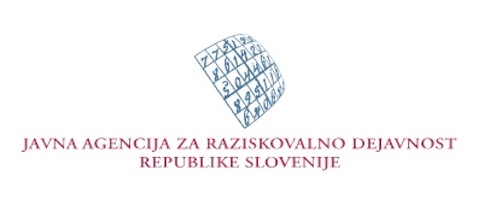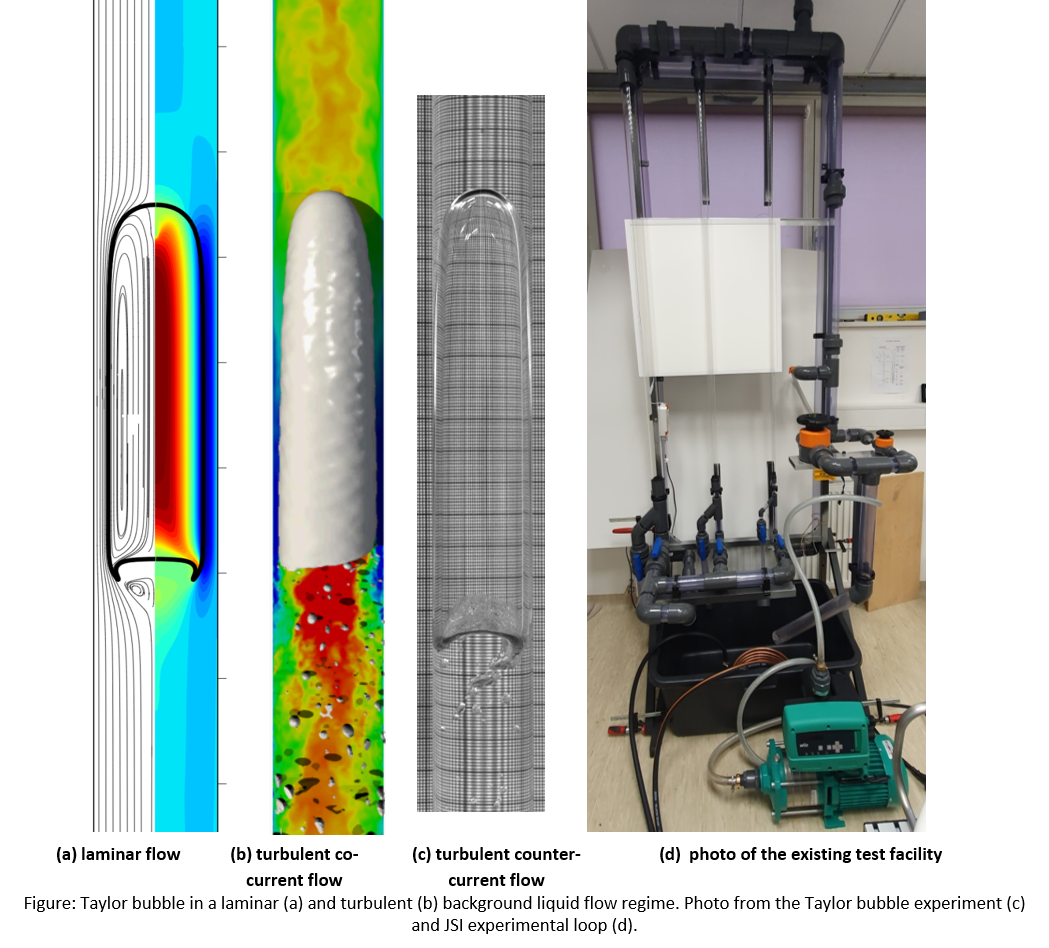Eksperimentalne in numerične raziskave vertikalnih čepastih tokov
Oznaka in naziv projekta
NC-0026 Eksperimentalne in numerične raziskave vertikalnih čepastih tokov
NC-0026 Experimental and numerical studies of vertical slug flows
Logotipi ARRS in drugih sofinancerjev

Projektna skupina
Vodja projekta: prof. dr. Iztok Tiselj (R4)
Sodelujoče raziskovalne organizacije: Povezava na SICRIS CEA, Francija, dr. Raksmy Nop
Sestava projektne skupine: Povezava na SICRIS dr. Blaž Mikuž, dr. Jure Oder, Jan Kren (MR)
Vsebinski opis projekta
Vsebinski opis projekta/ Project contents
SLO:
Navpični čepasti tok je ena od možnih oblik dvofaznih tokov, ki so pomembni za jedrsko tehniko in za številne industrijske aplikacije, kot so proizvodnja pare v geotermalnih elektrarnah, vrenje in kondenzacija v termoelektrarnah, zasilno hlajenje sredice reaktorja, transport ogljikovodikov v cevovodih, itd. Ključna značilnost takšnih tokov so tako imenovani Taylorjevi mehurji, to so mehurji plina v obliki izstrelka, ki se pretakajo v navpični cevi in zavzemajo skoraj celoten presek cevi ter so ločeni eden od drugega s tako imenovanimi "čepi" kapljevine.
Cilj predlaganih raziskav je analiza stabilnosti Taylorjevih mehurjev: Taylorjev mehur postopoma izgublja svoj volumen zaradi odcepljanja majhnih mehurčkov iz repa Taylorjevega mehurja. Nekateri odcepljeni mehurčki se ponovno združijo z velikim mehurjem zaradi recirkulacije toka za repom Taylorjevega mehurja, del odcepljenih majhnih mehurčkov pa zaostane za velikim mehurjem. V predlaganem projektu bomo zračni Taylorjev mehur opazovali v posebni konfiguraciji protitoka v navpični cevi, kjer je vzgon mehurja uravnovešen z nasprotnim tokom kapljevine. Ta konfiguracija omogoča daljša eksperimentalna opazovanja navidezno stacionarnega Taylorjevega mehurja in ga bomo reproducirali s poskusi in s simulacijami.
Eksperimentalni del projekta bo izveden na IJS-Slovenija s sodelovanjem CEA in bo obsegal vizualna opazovanja mehurja s hitro kamero in s sistemom PIV. Meritve bodo zagotovile natančne informacije o dogajanju v repu in za repom Taylorjevega mehurja: odcepljanje drobnih mehurčkov in njihovo ponovno združevanje s Taylorjevim mehurjem.
Numerične simulacije pojavov bo vodila skupina CEA. CEA in JSI bosta uporabljala različne računalniške programe za simulacije dvofaznih tokov: od programov, ki temeljijo na dvofluidnih modelih (NEPTUNE_CFD, CEA), do programov, ki temeljijo na tehnikah sledenja in ostrenja medfazne površine med kapljevino in plinom (TrioCFD, OpenFOAM - CEA in JSI).
S pomočjo poskusov in simulacij bomo predlagali natančnejše modele, ki so potrebni za opis odcepljanja drobnih mehurčkov iz Taylorjevega mehurja in njihovega združevanja v Taylorjev mehur.

ANG:
Vertical slug flow is one of the possible manifestation of a two-phase flows that are relevant for nuclear engineering and for many industrial applications, such as production of steam in geothermal power plants, boiling and condensation in thermal power plants, emergency core cooling of nuclear reactors or transportation of hydrocarbons in pipelines, etc... The key feature of such flows are the so called Taylor bubbles, i.e. a bullet shape bubbles, which flow in a vertical pipe and occupy almost the entire cross section of the pipe, and are separated by the liquid slugs.
The goal of the proposed research is analysis of the Taylor bubble stability: Taylor bubble is gradually loosing it's volume through the detachment of the small bubbles at the tail of the Taylor bubble. Some of the detached bubbles merge with the large bubble due to the recirculating flow behind the tail of the Taylor bubble, however, part of the detached small bubbles remains behind the large bubble. In the present project the air Taylor bubble will be observed in a special configuration of the counter-current flow in the vertical pipe, where the buoyancy of the bubble is counterbalanced by the downward directed liquid flow. This configuration allows longer experimental observations of the quasy-stationary Taylor bubble and will be reproduced with experiments and with simulations.
Experimental part of the project will be performed at JSI-Slovenia with collaboration of CEA and will comprise the visual observations of the bubble with the high-speed camera and with PIV system. These approaches will provide accurate information about the behavior of the bubble's tail: detachment of the tiny bubbles and their reentrainment into the bubble.
Numerical simulations of the phenomena will be led by the CEA group. CEA and JSI will use different computer codes for two-phase flow simulations: from codes based on two-fluid models (NEPTUNE_CFD, CEA), to codes based on interface-tracking and capturing techniques (TrioCFD, OpenFOAM - CEA and JSI).
Experiments and simulations will result in improved sub-models, which are needed to describe detachment of the small bubbles from the Taylor bubble and merging of the small bubbles into the Taylor bubble
Osnovni podatki sofinanciranja so dostopni na spletni strani SICRIS.
Faze projekta in opis njihove realizacije
The project is divided into two main work packages (WP), i.e. work package 1 (WP1) covering all the work dealing with the experiments and work package 2 (WP2) dealing with the numerical simulations. Both work-packages consist of roughly the same amount of dedicated working hours. They are divided into sub-tasks:
WP1: Experimental measurements, total ~12 person-months:
• Task 1: Construction/modification of the test section (2 person-months)
• Task 2: Measuring the TB disintegration (3 person-months)
• Task 3: Performing the PIV measurements (5 person-months)
• Task 4: Pressure drop measurements (2 person-months)
WP2: Numerical simulations, total ~12 person-months:
• Task 1: Simulations with two-fluid code NEPTUNE_CFD (5 p-m)
• Task 2: Performing the high-fidelity simulations with interface tracking codes (5 p-m)
• Task 3: New sub-models for bubble break-up and bubble merging (2 p-m)
Timeline (months, 0-24)
Experiments
WP1: Task1: 1-9
WP1: Task2: 7-18
WP1: Task3: 12-24
WP1: Task4: 7-24
Numerical simulations
WP2: Task1: 1-18
WP2: Task2: 1-24
WP2: Task3: 18-24